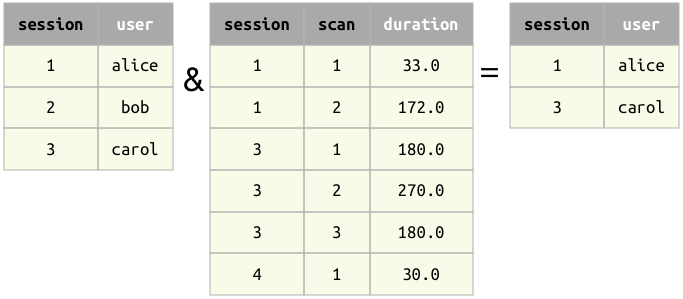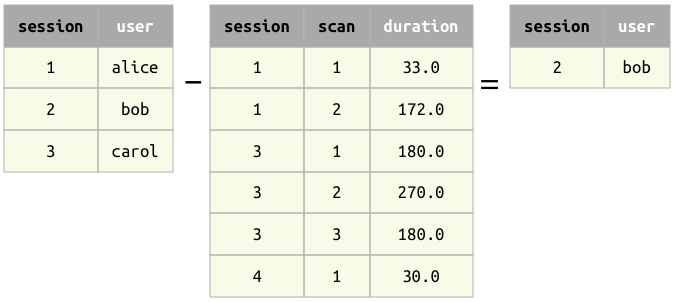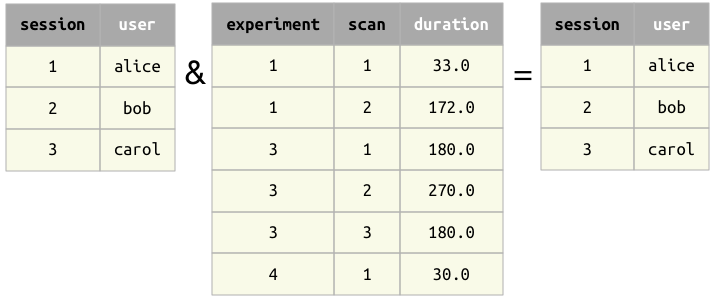Restriction¶
Restriction operators & and -¶
The restriction operator A & cond selects the subset of entities from A that meet
the condition cond.
The exclusion operator A - cond selects the complement of restriction, i.e. the
subset of entities from A that do not meet the condition cond.
Restriction and exclusion.

The condition cond may be one of the following:
- another table
- a mapping, e.g.
dict - an expression in a character string
- a collection of conditions as a
list,tuple, or PandasDataFrame - a Boolean expression (
TrueorFalse) - an
AndList - a
Notobject - a query expression
As the restriction and exclusion operators are complementary, queries can be
constructed using both operators that will return the same results.
For example, the queries A & cond and A - Not(cond) will return the same entities.
Restriction by a table¶
When restricting table A with another table, written A & B, the two tables must be
join-compatible (see join-compatible in Operators).
The result will contain all entities from A for which there exist a matching entity
in B.
Exclusion of table A with table B, or A - B, will contain all entities from A
for which there are no matching entities in B.
Restriction by another table.

Exclusion by another table.

Restriction by a table with no common attributes¶
Restriction of table A with another table B having none of the same attributes as
A will simply return all entities in A, unless B is empty as described below.
Exclusion of table A with B having no common attributes will return no entities,
unless B is empty as described below.
Restriction by a table having no common attributes.

Exclusion by a table having no common attributes.

Restriction by an empty table¶
Restriction of table A with an empty table will return no entities regardless of
whether there are any matching attributes.
Exclusion of table A with an empty table will return all entities in A.
Restriction by an empty table.

Exclusion by an empty table.

Restriction by a mapping¶
A key-value mapping may be used as an operand in restriction.
For each key that is an attribute in A, the paired value is treated as part of an
equality condition.
Any key-value pairs without corresponding attributes in A are ignored.
Restriction by an empty mapping or by a mapping with no keys matching the attributes in
A will return all the entities in A.
Exclusion by an empty mapping or by a mapping with no matches will return no entities.
For example, let's say that table Session has the attribute session_date of
datatype datetime.
You are interested in sessions from January 1st, 2018, so you write the following
restriction query using a mapping.
Session & {'session_date': "2018-01-01"}
Our mapping contains a typo omitting the final e from session_date, so no keys in
our mapping will match any attribute in Session.
As such, our query will return all of the entities of Session.
Restriction by a string¶
Restriction can be performed when cond is an explicit condition on attribute values,
expressed as a string.
Such conditions may include arithmetic operations, functions, range tests, etc.
Restriction of table A by a string containing an attribute not found in table A
produces an error.
# All the sessions performed by Alice
Session & 'user = "Alice"'
# All the experiments at least one minute long
Experiment & 'duration >= 60'
Restriction by a collection¶
A collection can be a list, a tuple, or a Pandas DataFrame.
# a list:
cond_list = ['first_name = "Aaron"', 'last_name = "Aaronson"']
# a tuple:
cond_tuple = ('first_name = "Aaron"', 'last_name = "Aaronson"')
# a dataframe:
import pandas as pd
cond_frame = pd.DataFrame(
data={'first_name': ['Aaron'], 'last_name': ['Aaronson']})
When cond is a collection of conditions, the conditions are applied by logical
disjunction (logical OR).
Thus, restriction of table A by a collection will return all entities in A that
meet any of the conditions in the collection.
For example, if you restrict the Student table by a collection containing two
conditions, one for a first and one for a last name, your query will return any
students with a matching first name or a matching last name.
Student() & ['first_name = "Aaron"', 'last_name = "Aaronson"']
Restriction by a collection, returning all entities matching any condition in the collection.

Restriction by an empty collection returns no entities.
Exclusion of table A by an empty collection returns all the entities of A.
Restriction by a Boolean expression¶
A & True and A - False are equivalent to A.
A & False and A - True are empty.
Restriction by an AndList¶
The special function dj.AndList represents logical conjunction (logical AND).
Restriction of table A by an AndList will return all entities in A that meet
all of the conditions in the list.
A & dj.AndList([c1, c2, c3]) is equivalent to A & c1 & c2 & c3.
Usually, it is more convenient to simply write out all of the conditions, as
A & c1 & c2 & c3.
However, when a list of conditions has already been generated, the list can simply be
passed as the argument to dj.AndList.
Restriction of table A by an empty AndList, as in A & dj.AndList([]), will return
all of the entities in A.
Exclusion by an empty AndList will return no entities.
Restriction by a Not object¶
The special function dj.Not represents logical negation, such that A & dj.Not(cond)
is equivalent to A - cond.
Restriction by a query¶
Restriction by a query object is a generalization of restriction by a table (which is also a query object), because DataJoint queries always produce well-defined entity sets, as described in entity normalization. As such, restriction by queries follows the same behavior as restriction by tables described above.
The example below creates a query object corresponding to all the sessions performed by
the user Alice.
The Experiment table is then restricted by the query object, returning all the
experiments that are part of sessions performed by Alice.
query = Session & 'user = "Alice"'
Experiment & query